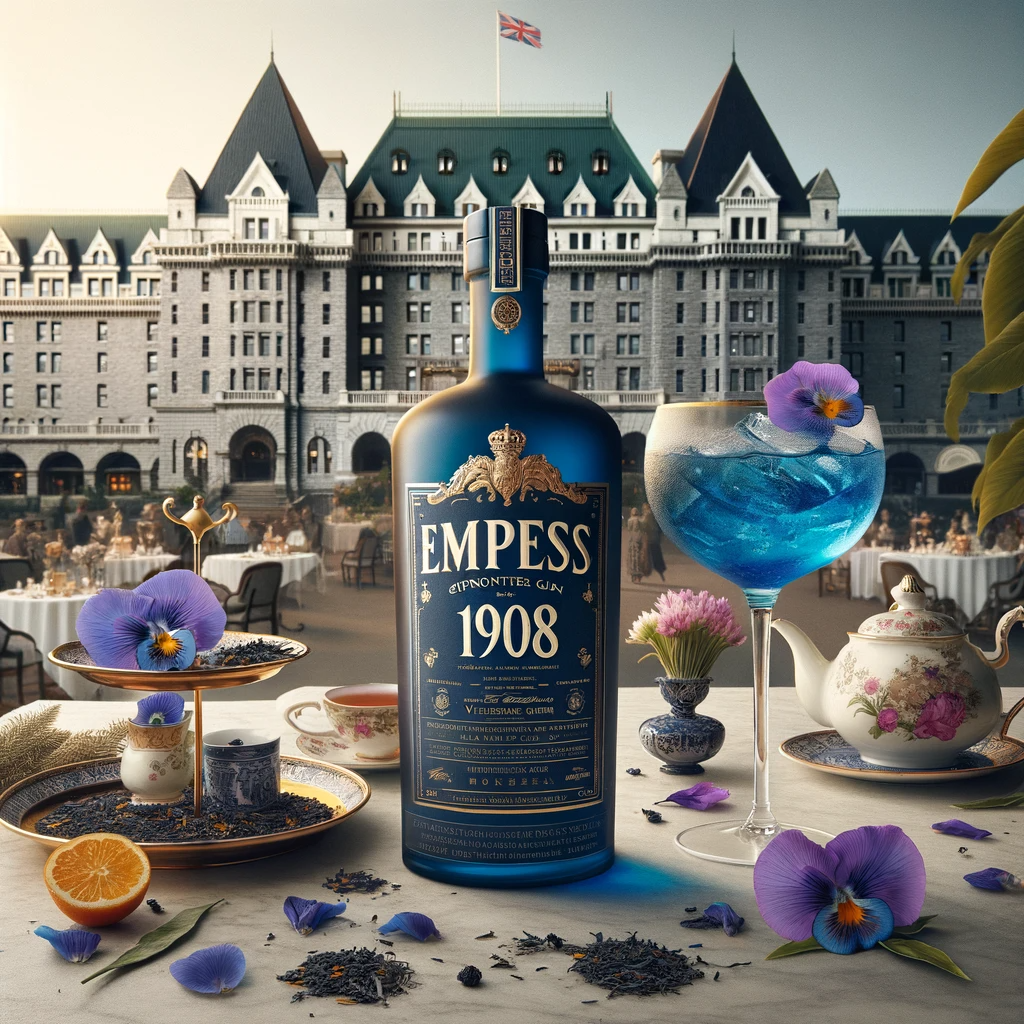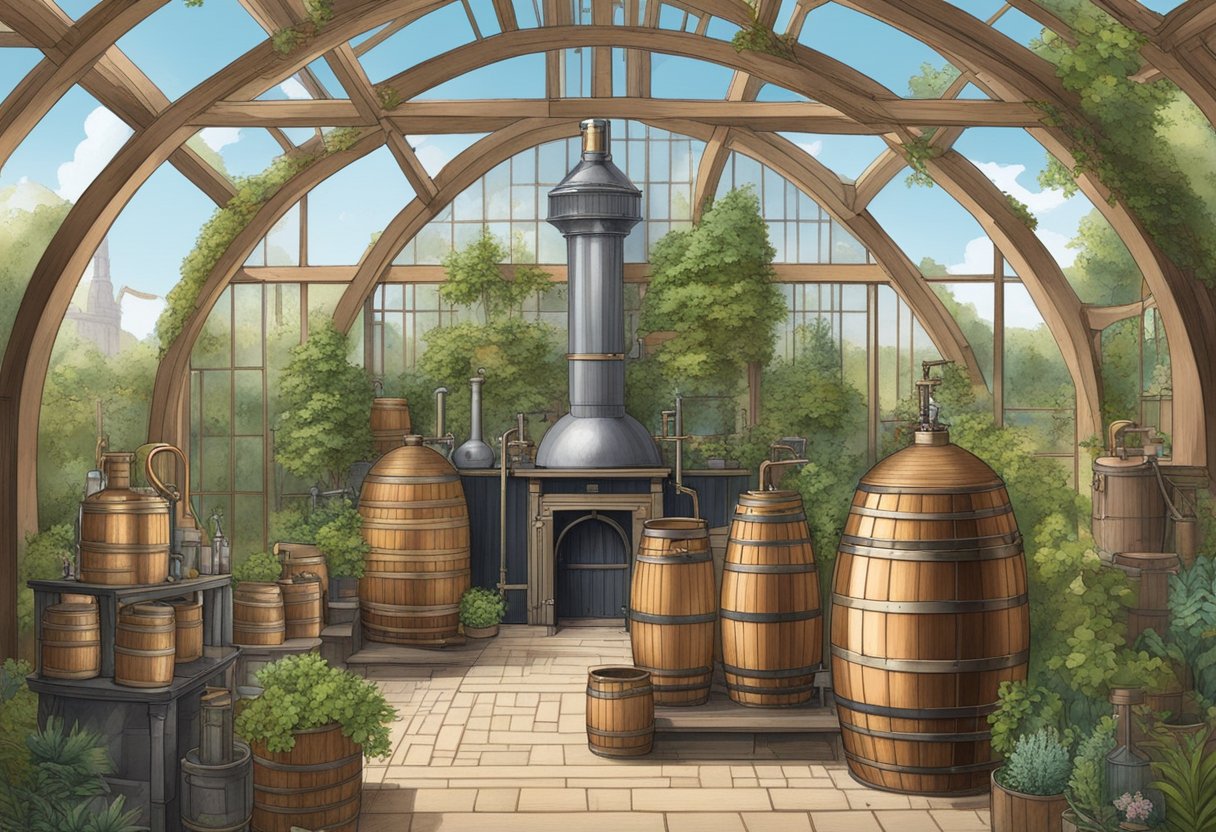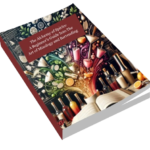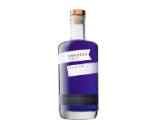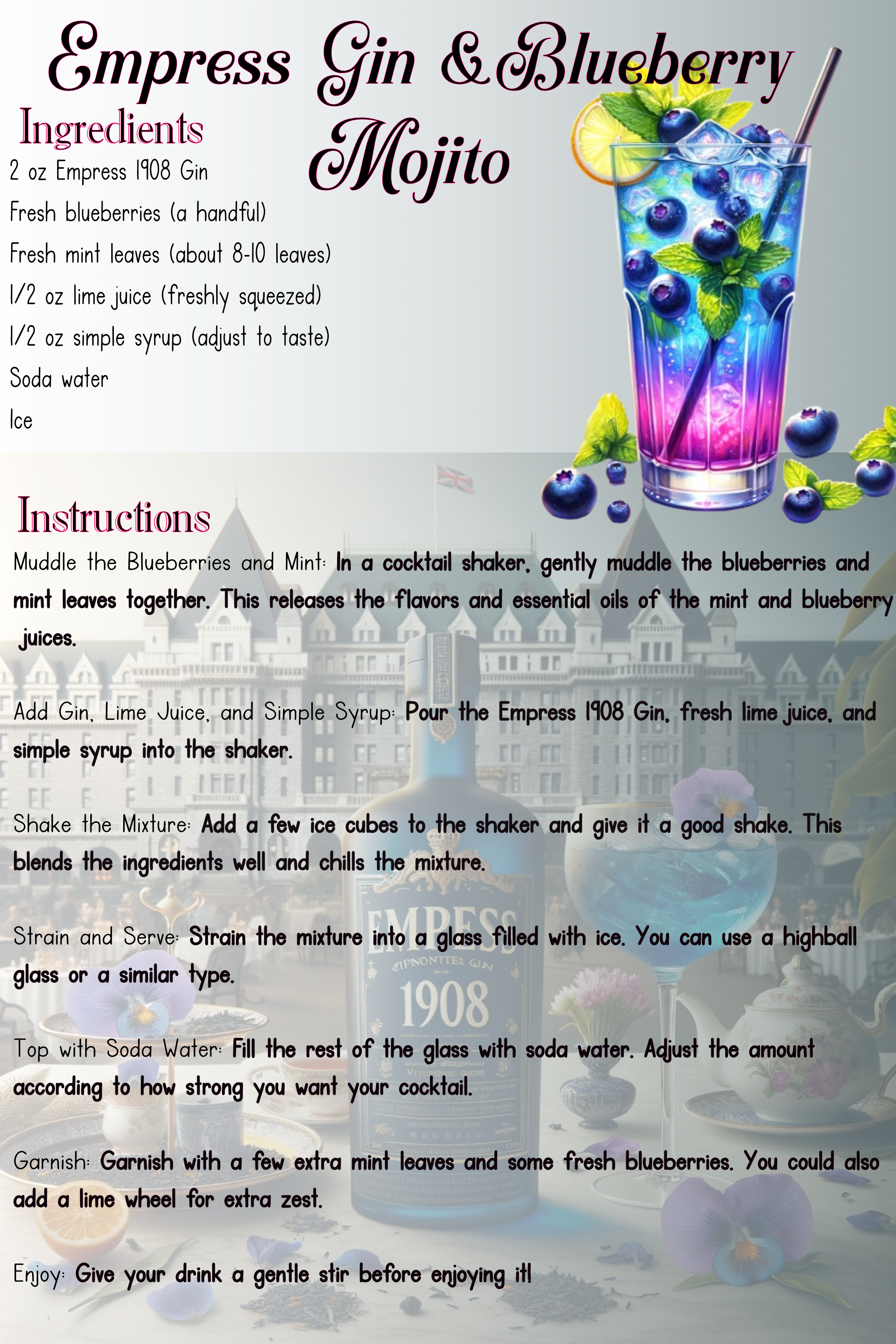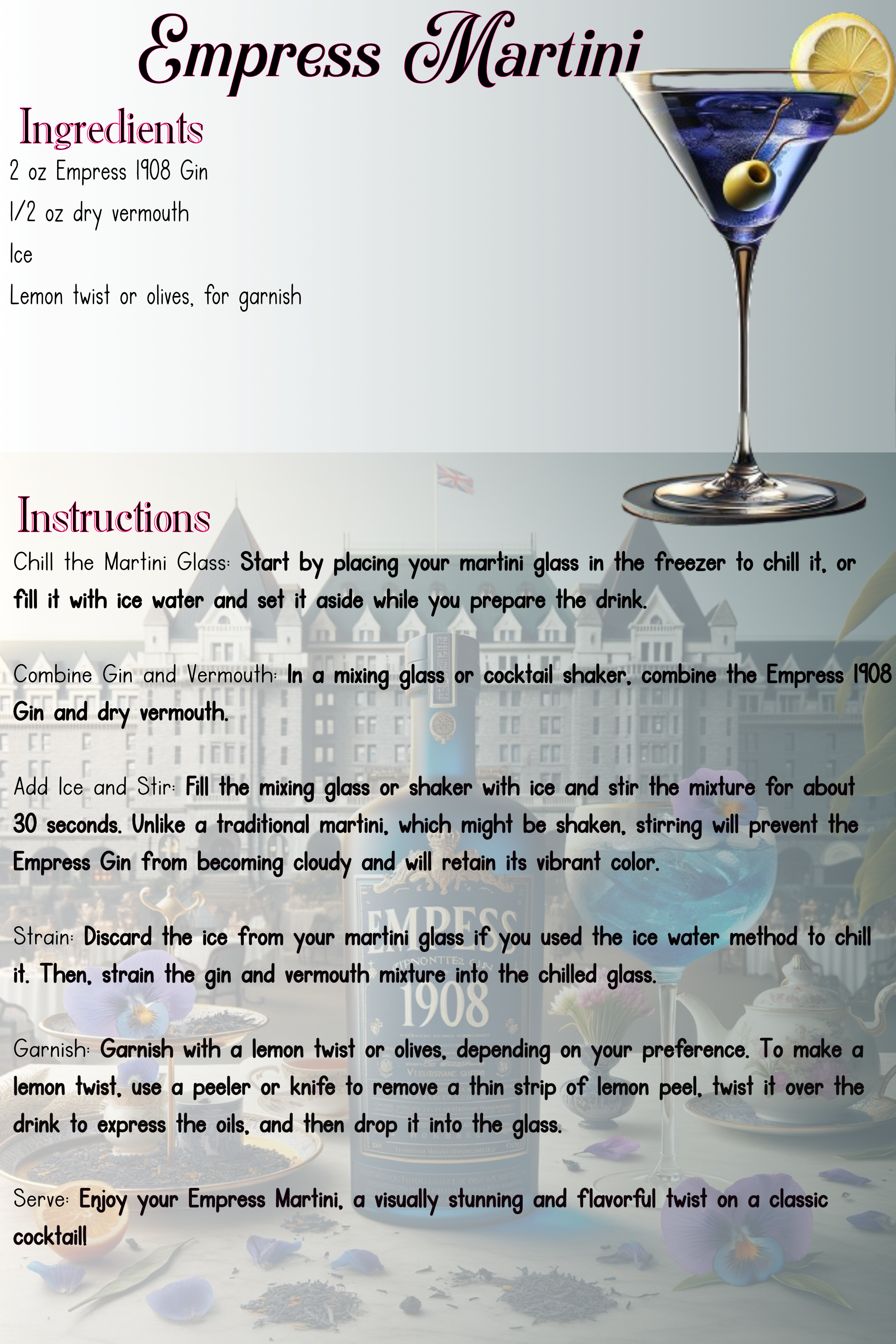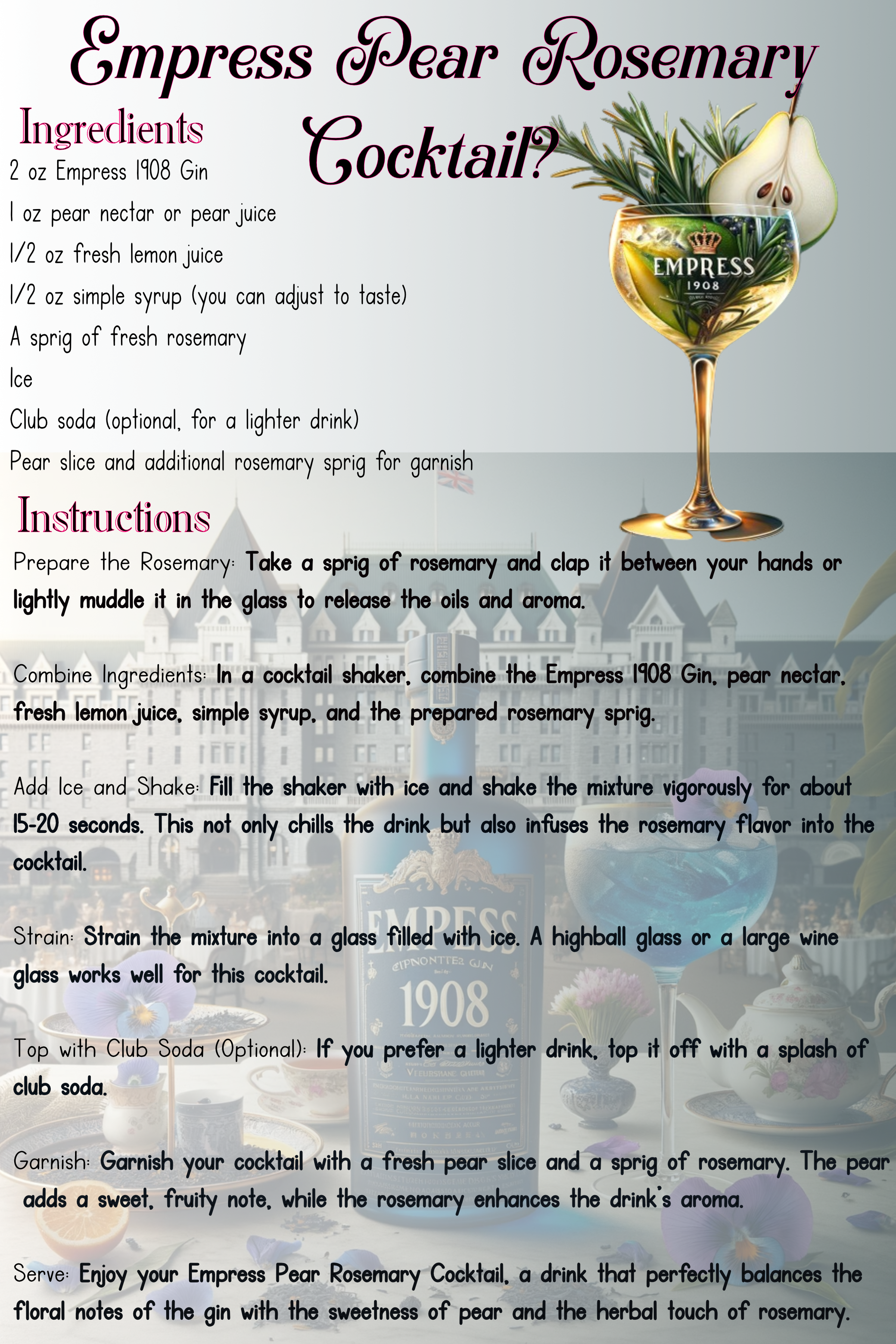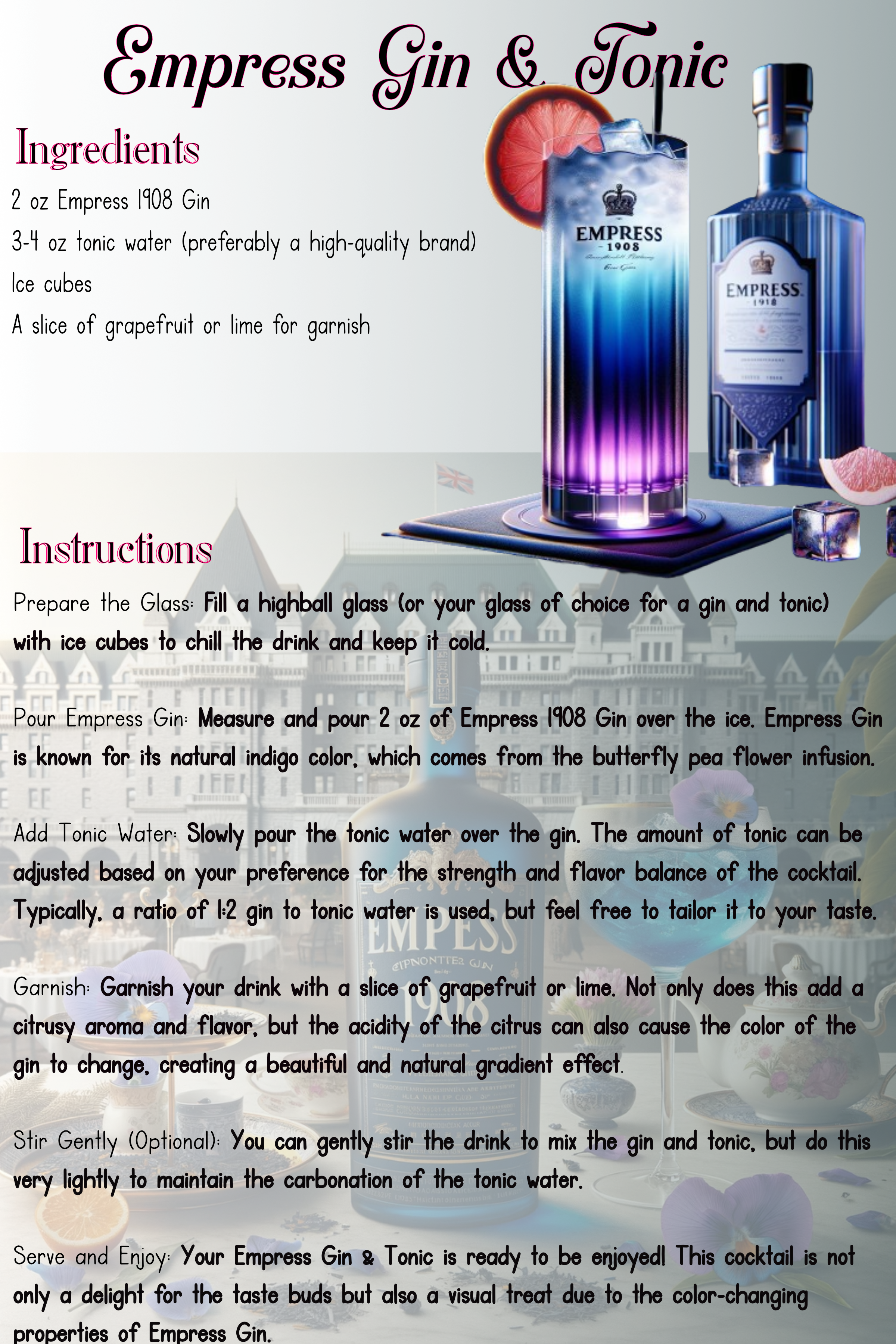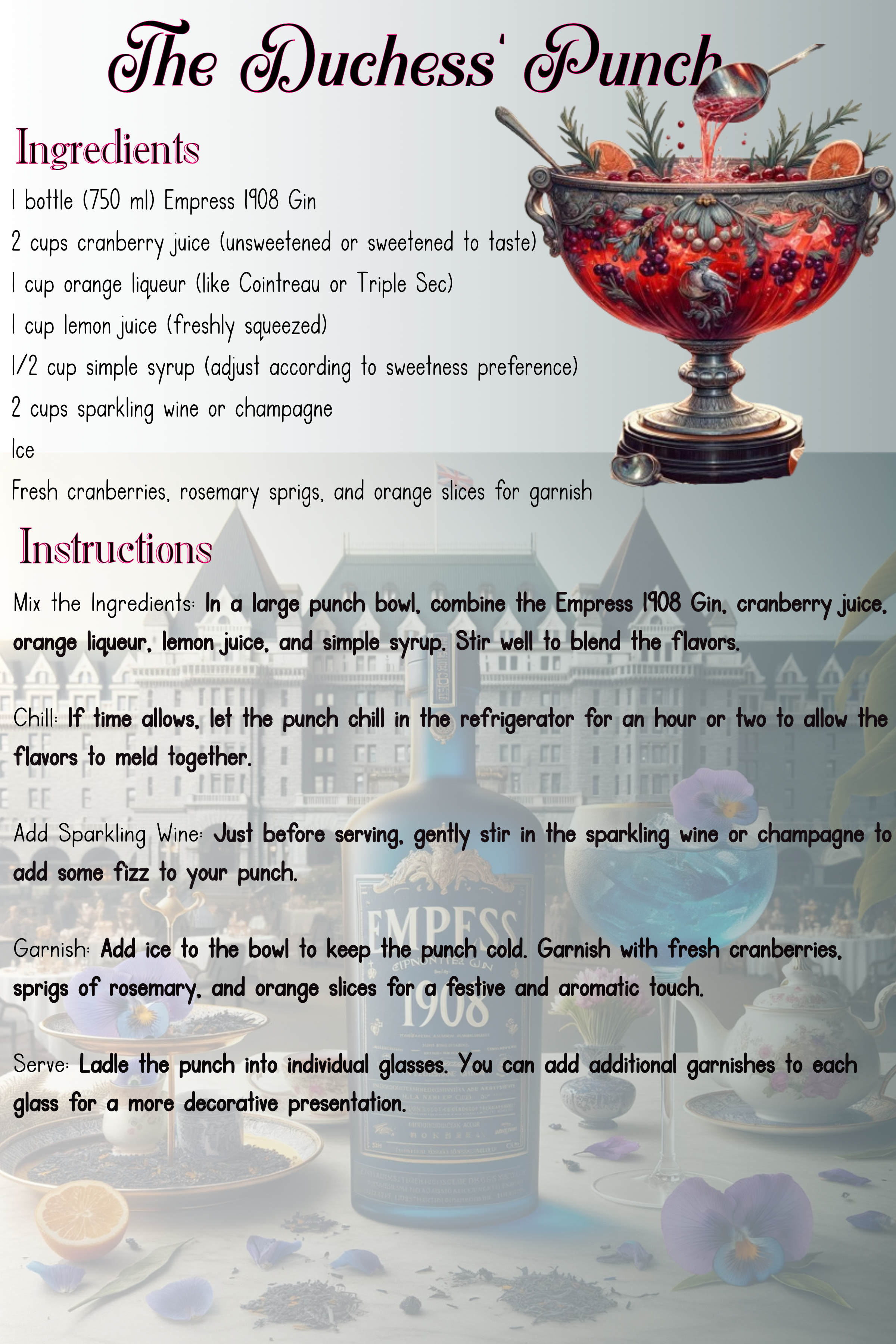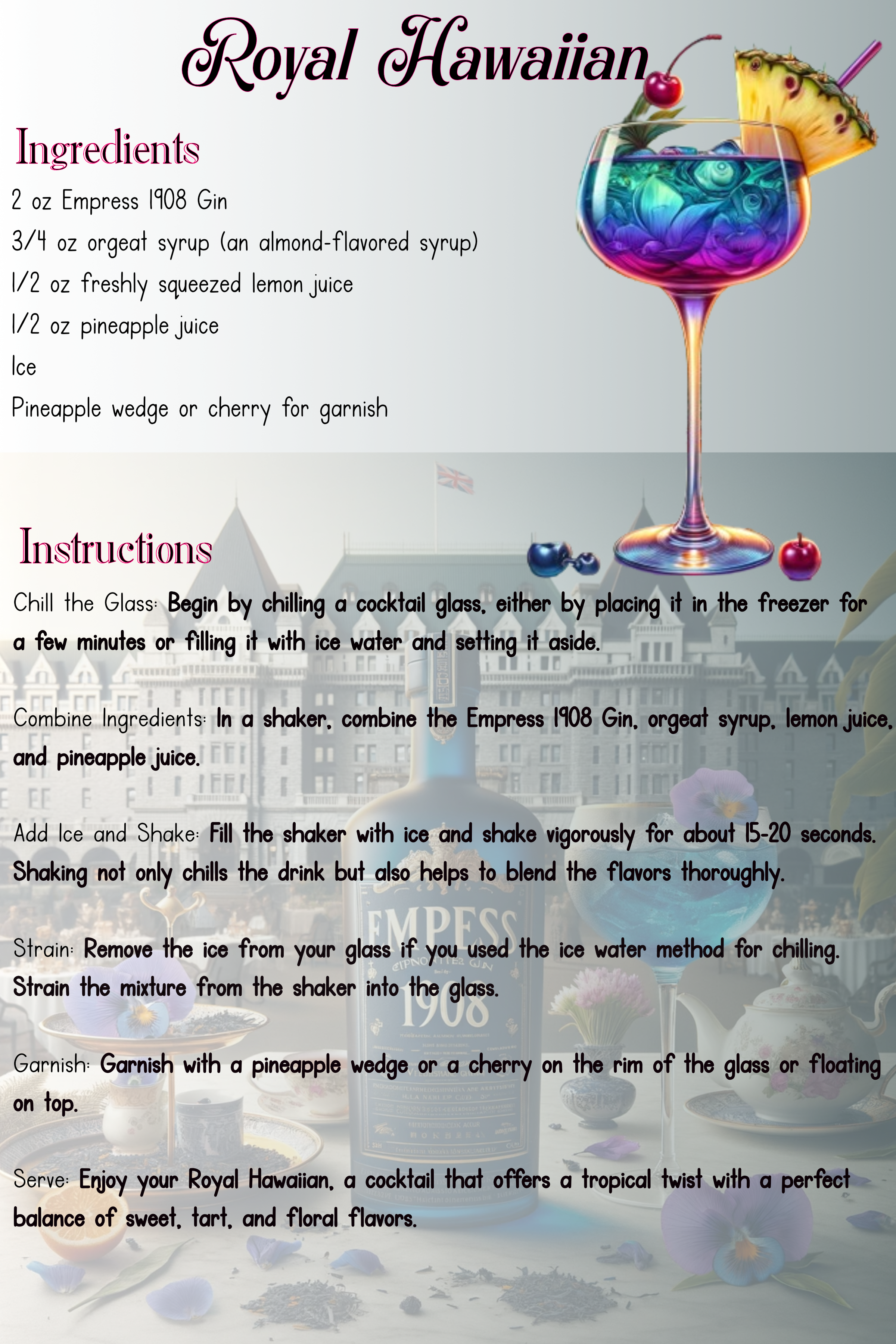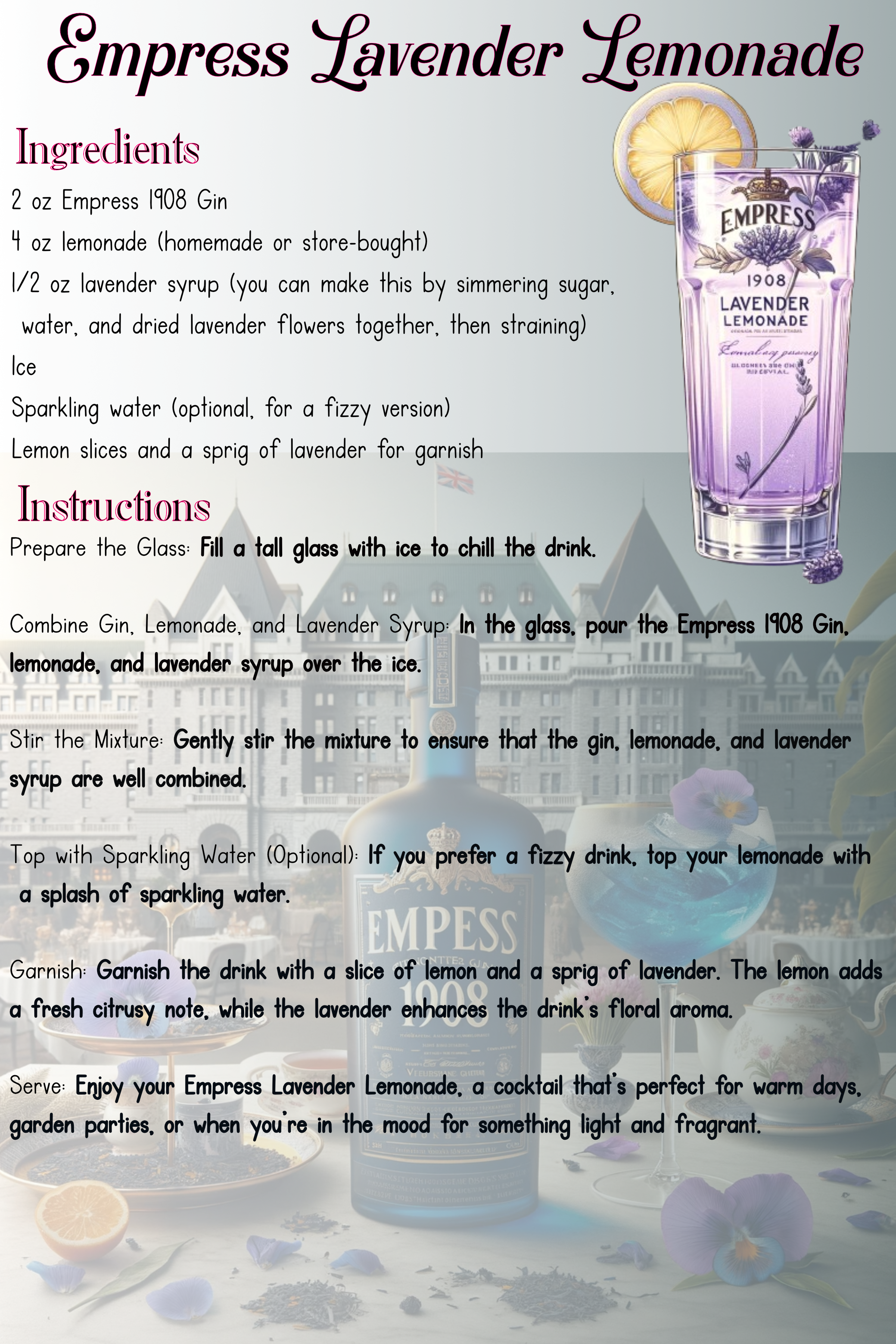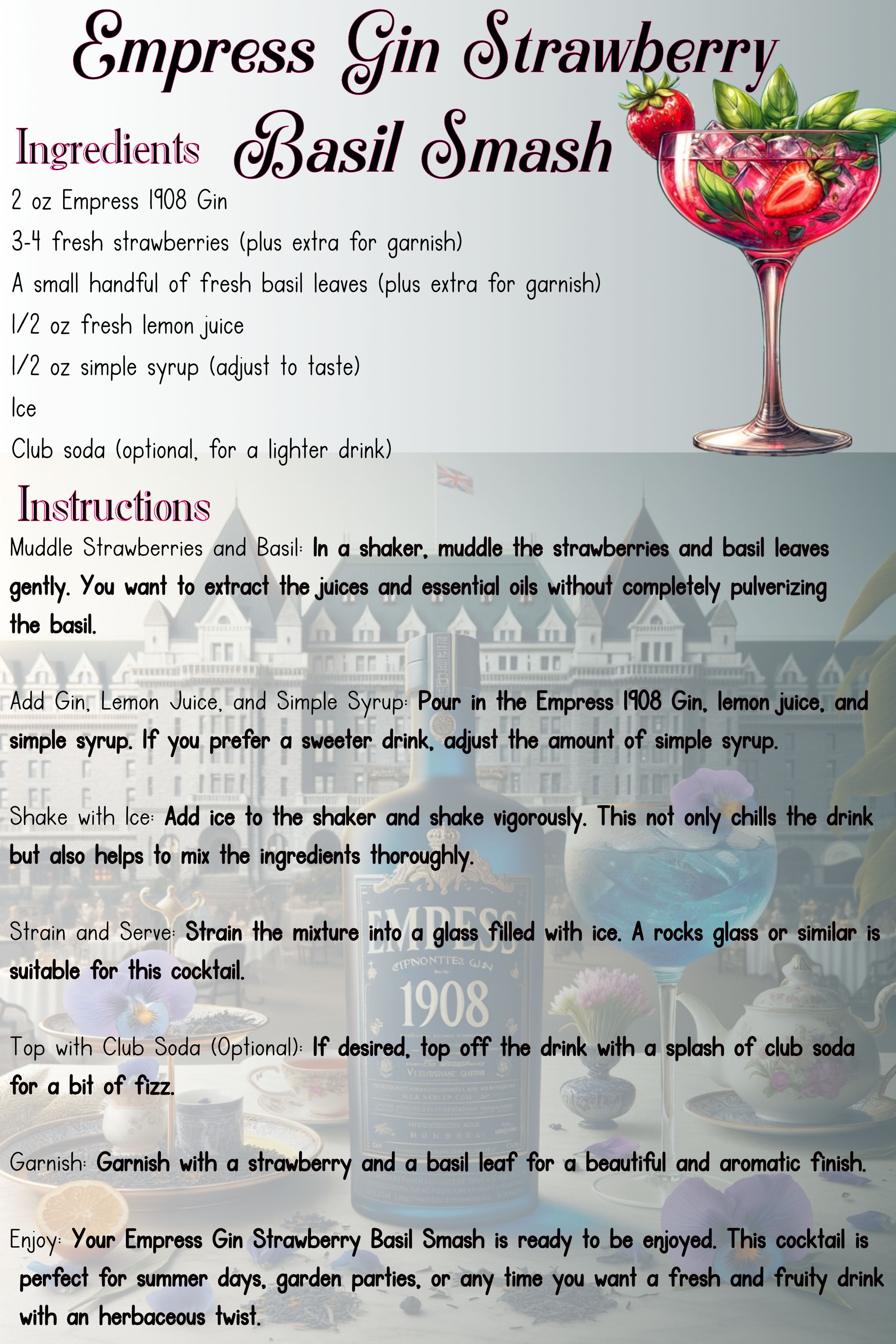Empress Gin: Revealing the Secrets of Its Unique Flavor and Color
Empress 1908 Gin, an artisanal and distinctive spirit, originates from Canada and is produced by the acclaimed Victoria Distillers, who are renowned for their dedication to innovation and excellence. Consequently, this gin is distinguished by its striking indigo hue and unique flavor. Furthermore, its rich color and intricate taste profile stem from a selection of thoughtfully chosen botanicals, most notably the butterfly pea blossom, which imparts both a deep color and a touch of intrigue to the gin.
Empress 1908 Gin, launched in 2017, was crafted to honor the historic Fairmont Empress Hotel in Victoria, British Columbia. Peter Hunt and the team at Victoria Distillers developed this recipe to capture the essence and rich heritage of the hotel.
The gin’s signature indigo color, a serendipitous result during distillation, originates from butterfly pea blossoms. Moreover, these blossoms, in combination with other meticulously chosen botanicals, contribute significantly to its unique flavor profile. This includes elements such as juniper, coriander, grapefruit peel, ginger root, cinnamon, rose, and lavender.
The gin’s name, “Empress 1908,” references the year the hotel was built, reflecting its Edwardian architecture with French Renaissance revival influences. Victoria was a crucial hub for the Canadian Pacific Railway and the maritime trade in the Pacific during that era.
Since its introduction, Empress Gin has become increasingly popular, celebrated for its remarkable color and flavor. Its natural ability to change color from indigo to shades of pink or blue when mixed adds an extra element of allure.
The blend of both traditional and modern botanicals, skillfully combined with its aesthetic appeal, effectively mirrors the spirit of the Empress Hotel and stands as a tribute to the creativity of its creators. Furthermore, the widespread acclaim of Empress 1908 Gin serves as a testament to the passion and skill involved in its making.
Production Process
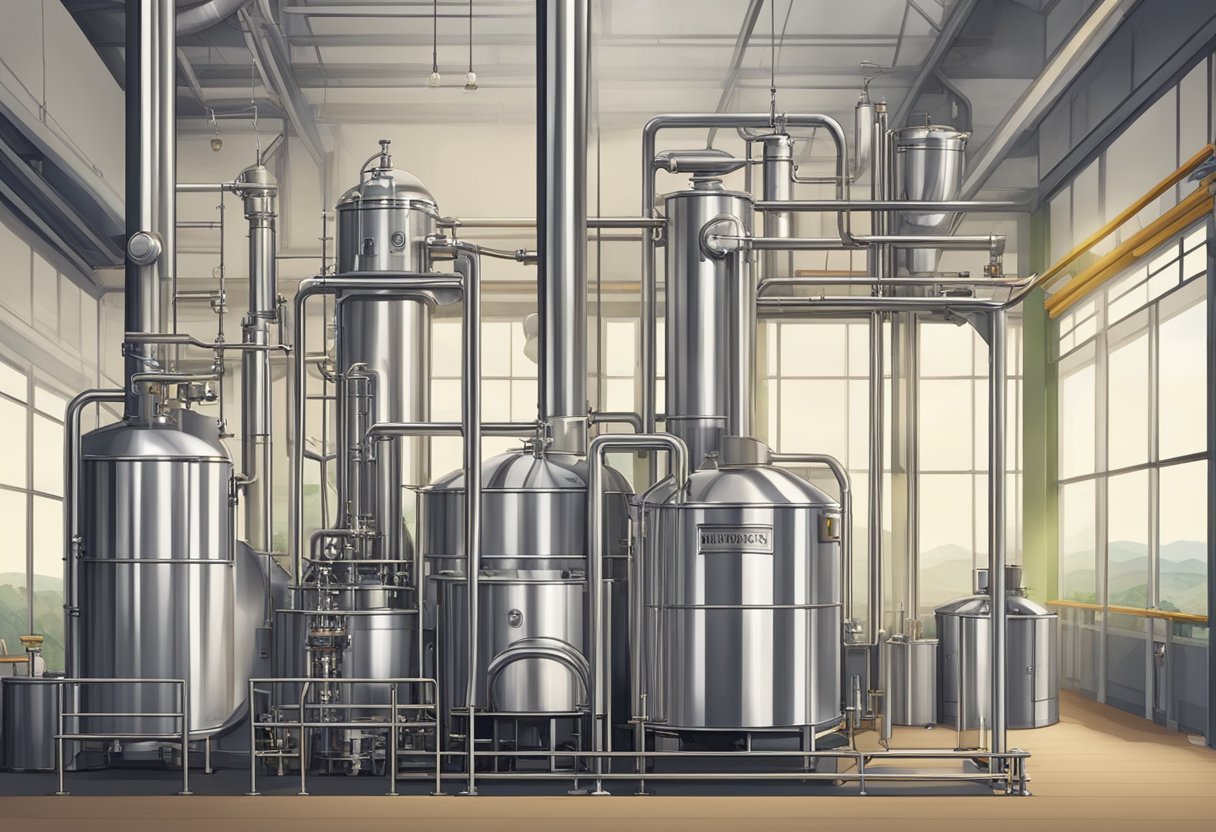
Botanical Ingredients
This unique spirit is distinguished by its specially chosen botanicals that shape its rich and exotic taste. Its primary ingredients are juniper, giving it the quintessential gin character, grapefruit peel and coriander seed introducing a citrus zest, cinnamon bark infusing a spicy warmth, and rose petals along with ginger root providing a subtle floral essence with a spicy undercurrent.
Production Technique
The production of Empress 1908 Gin starts with an overnight maceration of its botanicals, setting the stage for the distillation process. Crafted by Victoria Distillers, among the most established artisan distilleries in British Columbia, the gin is distilled in small-batch copper pot stills. This careful maceration period allows for a full extraction of flavors, resulting in a gin that’s exceptionally smooth and well-rounded.
In the making of Empress Gin, an eco-friendly approach is adopted during distillation. The initiative to repurpose the heat from the stills conserves around 7,000 liters of water for each batch. This dedication to water conservation and energy efficiency differentiates Empress 1908 Gin from its competitors.
The distinctive distillation approach of Empress Gin, merging select botanicals with an eco-conscious production method, yields a spirit that stands out. Whether mixed in traditional gin cocktails or paired with premium mixers, it promises an indulgent experience.
Tasting Profile
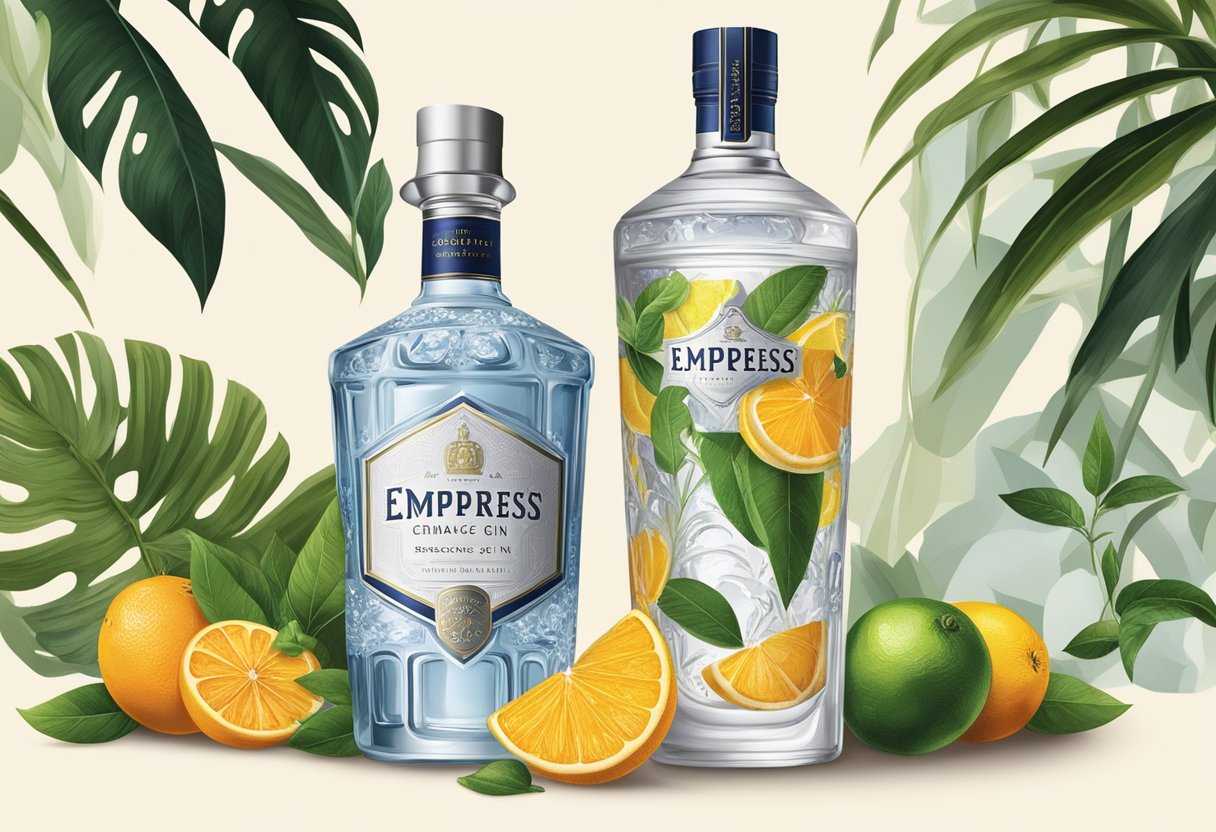
Tasting a spirit like Empress 1908 Gin is a multi-sensory experience that unfolds in several stages:
Visual Appeal
Your experience begins the moment you pour the gin into a glass. Empress Gin is renowned for its striking deep indigo color. This visual allure sets the stage for the tasting journey.
Aroma
As you bring the glass closer, take a gentle inhale. Initially, you’ll notice the clean, piney scent of juniper, the hallmark of any classic gin. Following this, the zesty and bright notes of grapefruit peel become apparent, along with the sweet, citrusy essence of coriander seed. Moreover, if you allow the gin to breathe for a moment, subtle hints of the warm, woody spice from cinnamon bark and the delicate floral notes from rose petals will gradually emerge, complemented by a slight undertone of the sharp, spicy fragrance of ginger root.
First Sip
Take a small sip and let the gin coat your palate. The juniper will likely be the first to greet your taste buds, followed quickly by the fresh, tangy burst of citrus from the grapefruit. The coriander adds complexity with its warm, nutty, and slightly spicy flavor.
Mid-Palate
the gin lingers in your mouth, the warm spices become more pronounced. The cinnamon provides a comforting warmth without overpowering, and it might remind you of baked goods or spiced tea. This is where the balance of flavors starts to shine, as the spice from the cinnamon and ginger root is softened by the elegance of the rose petals.
Finish
As you swallow, the gin leaves a smooth and lingering finish. There’s a slight heat from the ginger root, which is tempered by the floral notes that remain on the tongue. The overall finish is clean, with a balanced interplay between warmth, spice, and floral sweetness.
Overall Experience: The tasting journey of Empress 1908 Gin is one of balance and harmony, with each botanical playing its part without overwhelming the others. It’s a gin that’s as much a delight to the eyes as it is to the palate, offering a unique experience that invites you to explore the depth and subtlety of its flavors. Whether you’re a gin connoisseur or a curious newcomer, Empress Gin makes for a memorable tasting adventure.
Complexity with Mixers
If you decide to enjoy Empress 1908 Gin with mixers or in a cocktail, you must try the spirit on its own. That way you are going to appreciate the transformation when mixers are crafted onto the playing field. The change in taste and in color is a sensory trip. The pH-sensitive butterfly pea blossom causes the gin to change color from its original indigo to various shades of pink or lavender, depending on the mixer’s acidity. It’s exciting to taste the different aspects of the gin that it lets out.
Empress Gin Recipes
The silky finish of Empress Gin lends itself to a myriad of cocktail creations. Among the favorites are:
Empress & Tonic: This spin on the time-honored gin and tonic uses Empress 1908 Gin and manifests a captivating shift from indigo to pink when tonic water is added.
Victoria’s Garden: A delightful concoction of Empress Gin blended with lemon juice, simple syrup, and crushed basil leaves, adorned with slices of cucumber and lemon.
Empress Martini: An elegant variation of the traditional martini, combining Empress Gin with vermouth and a hint of orange bitters, and finished with a twist of lemon or a few olives.
Remember to take advantage of Empress 1908 Gin’s color-changing magic as you mix your drinks. The transformation from a royal indigo to an alluring pink with the addition of citrus or tonic water not only makes for an impressive visual but also can spark up conversations.
Signature Empress Gin Cocktails
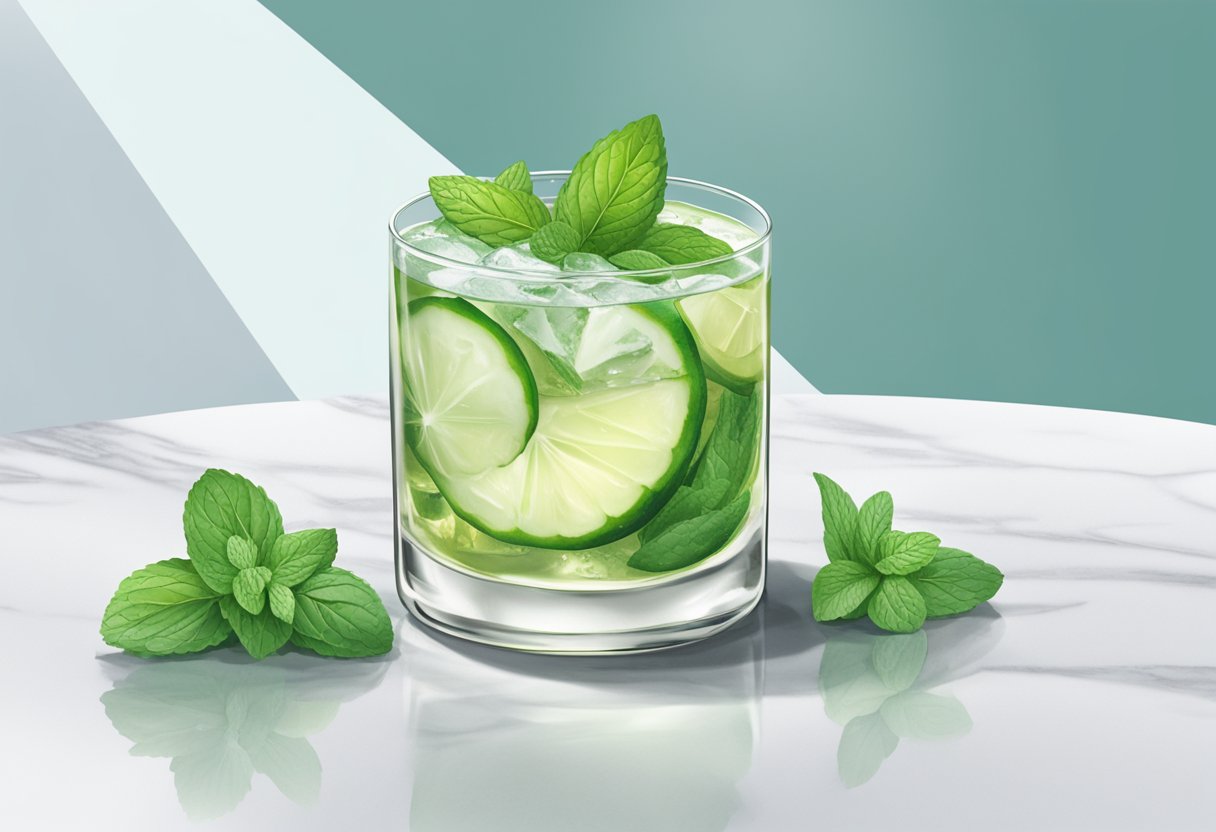
Empress Gin captivates with its deep indigo shade and complex taste profile, serving as a base for both timeless and inventive cocktails. Here’s a selection of Empress 1908 Gin’s signature concoctions that highlight the spirit’s distinctiveness.
Empress & Tonic: This flagship reinvents the gin and tonic experience. Blending Empress Gin with high-quality tonic water yields a sophisticated and invigorating drink. To craft it, combine 2 oz of Empress 1908 Gin with 3 oz of premium tonic water and accentuate with a slice of grapefruit.
Empress Gin Strawberry Basil Smash: This is another tantalizing option, marrying the gin’s botanicals with the aromatic essence of strawberries and basil. Crush strawberries and basil leaves together, then add Empress 1908 Gin, lemon juice, and simple syrup, shake well, and serve in a glass.
Empress Lavender Lemonade: For a touch of floral elegance. This perfumed blend infuses the gin with handcrafted lemonade and lavender syrup. Mix the gin with lemon juice and lavender syrup, top with a splash of sparkling water, and garnish with lavender.
Royal Hawaiian: This choice offers a touch of sophistication, featuring a tropical mix of Empress 1908 Gin, orgeat syrup, pineapple juice, and lemon juice. Delivering a harmony of tastes. Shake these ingredients with ice, strain into an elegant glass, and decorate with a pineapple slice or a cherry.
Empress Pear Rosemary Cocktail: A distinct fusion of sweet pear and aromatic rosemary that complements the gin’s botanical blend. Shake the gin with pear nectar, lemon juice, simple syrup, and a sprig of rosemary, strain into a glass over ice, and garnish with a pear slice.
These signature drinks highlight the multifaceted character of this spirit. And are perfect for enhancing your cocktail repertoire, whether you’re hosting a soiree or refining your bartending flair.
Mixing Techniques
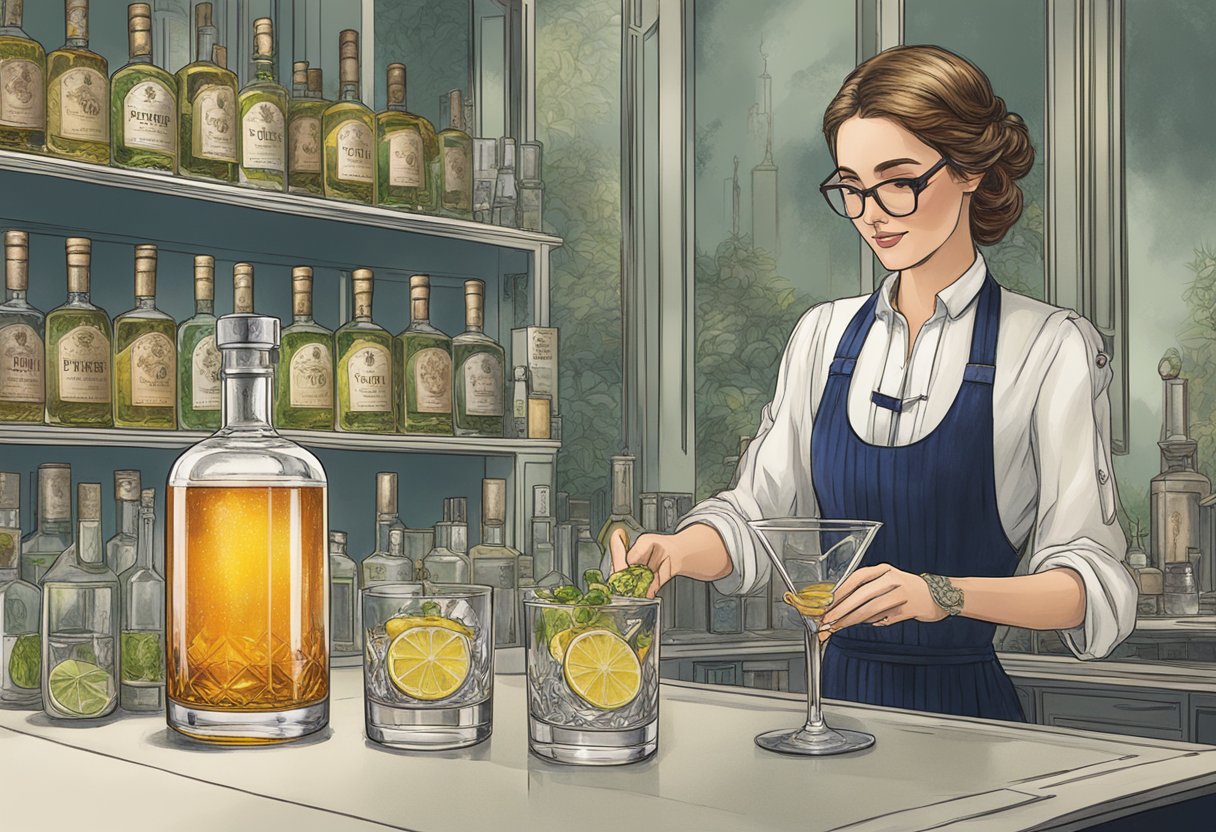
Download this short guide for more detail about shaking, stirring and other basic information about mixology.
Shaking VS Stirring
The decision to shake or stir a cocktail can significantly influence its final texture and taste. Specifically, cocktails containing ingredients like citrus juices, egg whites, or cream should be shaken. This action introduces air and consequently ensures that the components are thoroughly combined, resulting in a harmonious blend.
On the other hand, cocktails where the gin, whiskey or other spirits are the main focus, and the mixers play a secondary role in complementing and enhancing the flavor of the alcohol. Such as an Old Fashioned, a Martini, and a Manhattan. The term given to mixed drinks like these is spirit-forward cocktails. The cocktails benefit from stirring. This technique preserves the subtle flavors and gives the drink a smooth, clear consistency. These types of drinks are often preferred by those who appreciate the distinct flavors of the spirits themselves.
Keep these tips in mind:
Shake: for cocktails that have citrus, egg whites, or cream.
Stir: for preparing refined spirit-centric drinks, including those with Empress 1908 Gin.
Garnishing Essentials
The art of garnishing is essential in elevating both the visual charm and taste of a cocktail. For enhancing your Empress Gin creations, consider these garnishing strategies:
Citrus Twists: Craft a slender twist of citrus peel using a channel knife or peeler, then twist it over the drink to release the essential oils, adding a fragrant complexity. Lemon or grapefruit peels are perfect for this.
Floral Accents: Incorporate edible flowers like those used in the Empress Gin and Blueberry Mojito for a splash of color and subtle flavor. Always choose flowers that are safe for consumption and free from chemicals.
Herbal Garnishes: A sprig of fresh herbs can tie together the cocktail’s taste profile, particularly when they echo the gin’s botanicals. Mint, rosemary, and basil are favorites for this purpose.
Fruit Slices: Add a slice of fruit inside the glass or on the rim for a burst of flavor and color. Citrus and berries complement Empress 1908 Gin cocktails well.
By selecting garnishes that align with the flavors in your cocktail and present a feast for the eyes, you can craft an Empress Gin cocktail that is as stunning as it is delectable. Attention to the finer points of mixing and garnishing can turn a good cocktail into an unforgettable one.
Pairing Empress Gin
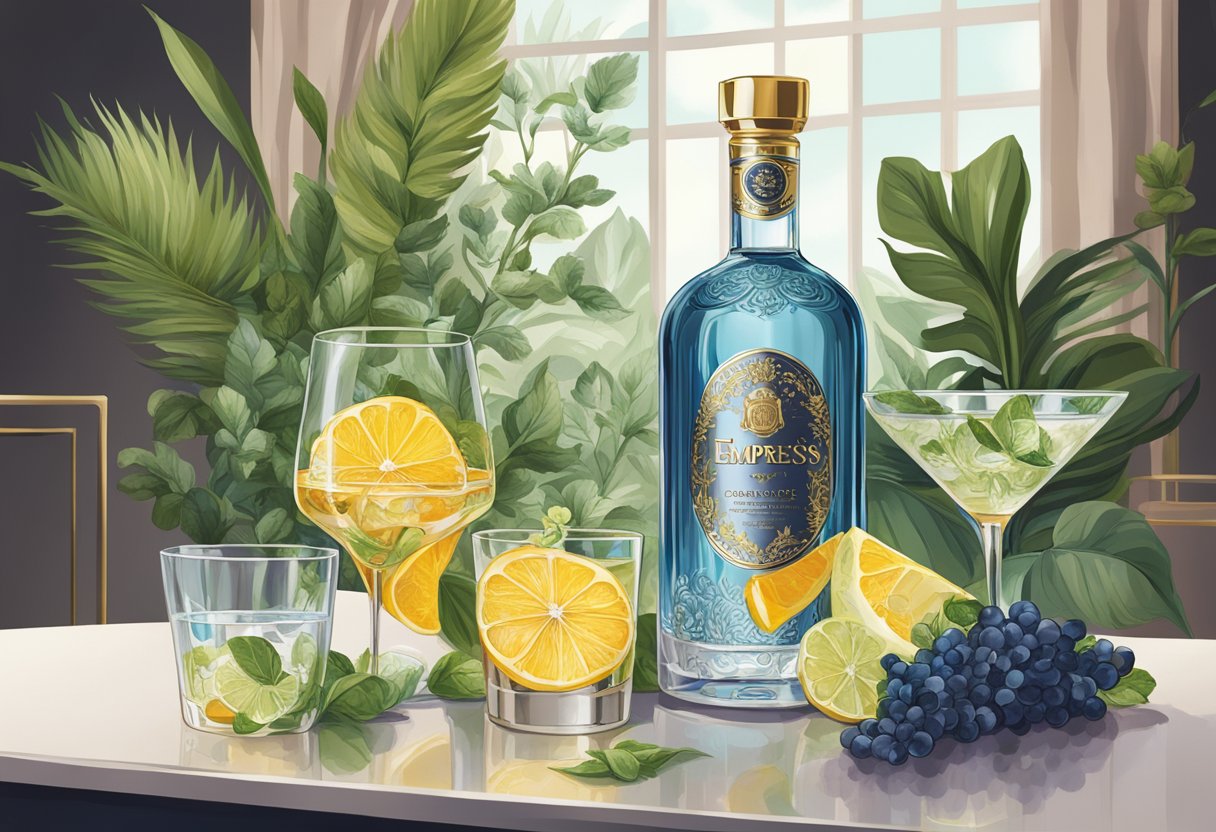
Culinary Combinations
The unique taste of Empress 1908 Gin, with its blend of floral, earthy, and citrus notes, makes it a prime candidate for pairing with food. Opt for fresh components that can draw out these flavors. Berries, for instance, marry well with the gin, their fresh tartness enhancing its floral undertones.
For a classic complement, turn to seafood such as charcoal-grilled shrimp or pan-seared scallops. These dishes let the distinct notes of Empress 1908 Gin come to the forefront. Similarly, dishes seasoned with herbs, like rosemary-infused chicken or pasta tossed with garlic and herbs, accentuate the gin’s earthy notes.
Occasions and Events
Empress 1908 Gin’s versatility lends itself to a range of social settings and events. Consider these ideas for featuring Empress Gin:
Cocktail Parties: Showcase original Empress 1908 Gin cocktails, like the innovative Empress Gin and Blueberry Mojito, to offer guests a taste of something extraordinary.
Holiday Gatherings: Bring an elegant flair to holiday celebrations with themed cocktails, such as the Duchess Punch—a blend of Empress 1908 Gin, cranberries, rosemary, and bubbly—that’s sure to dazzle.
Dinner Parties: Introduce a touch of class to your dinner parties with Empress Gin pairings. Offer a pear and rosemary cocktail as an accompaniment to your starters or main dishes. In essence, Empress 1908 Gin is an exquisite spirit that complements a wide array of dishes and adds an element of elegance to any celebration. Its distinctive flavor and striking color are guaranteed to make an impression on your guests.
Serving Suggestions
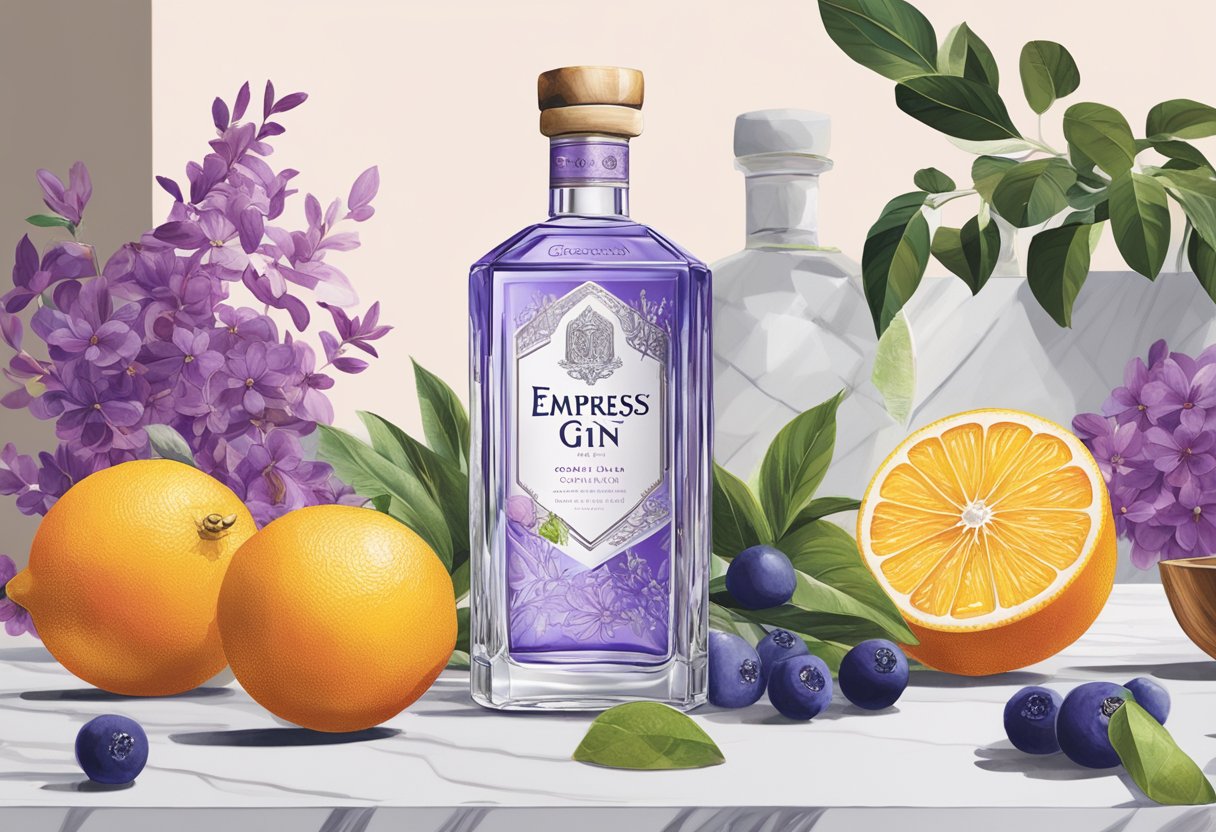
Glass Selection
Choosing the appropriate glassware is crucial when presenting Empress Gin cocktails, as it enhances both the aesthetic and sensory enjoyment. For an Empress Gin & Tonic, a highball glass brimming with ice is suitable. Conversely, an Empress Martini is best served in a classic martini glass to elevate its elegance.
Other glassware choices include:
Coupe Glass: Best suited for timeless and chic cocktails such as the Bee’s Knees.
Rocks Glass: The go-to for succinct drinks like the Empress Pear Rosemary Cocktail.
Collins Glass: Apt for elongated, invigorating beverages like the Raspberry Bramble.
Optimal Chill and Dilution
The excellence of your Empress 1908 Gin cocktails partly lies in serving them at the correct chill level with precise dilution. It’s about finding the harmony among temperature, taste, and texture.
Take the Empress Gin and Blueberry Mojito, which requires a generous amount of ice to maintain its coolness and zest as detailed in its recipe. Meanwhile, a stirred Empress Martini achieves dilution through stirring over ice, which not only cools but also mellows the drink for a silky mouthfeel.
Bear in mind these general practices:
Shaken cocktails: Use ample ice when shaking to properly chill and dilute the cocktail.
Stirred cocktails: Stir with ice until the concoction is sufficiently cold and diluted.
Built-in-glass cocktails: Start with ice in the glass, then pour the ingredients over it to chill the beverage while controlling dilution.
Explore different Empress 1908 Gin concoctions to discover the ideal chill and dilution for each cocktail style, adhering to these foundational tips.
Buying Guide
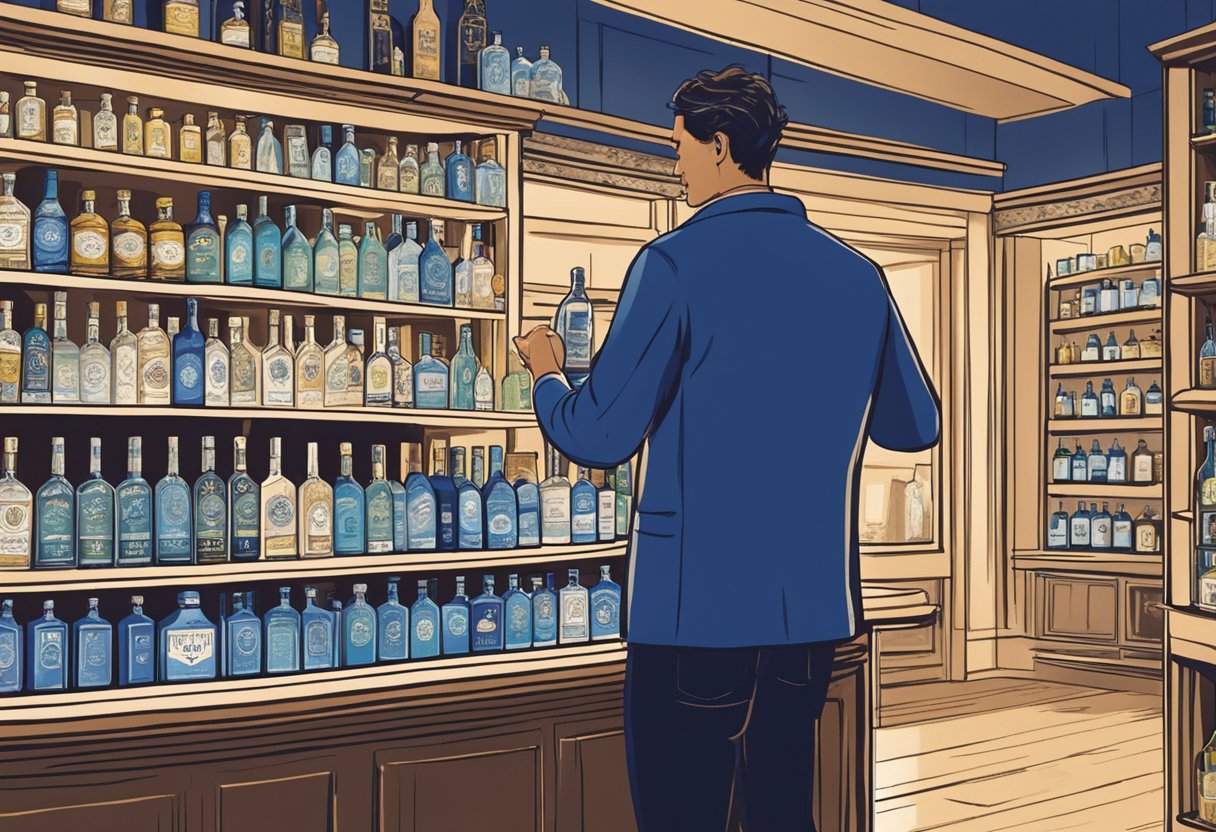
Finding Empress Gin
To locate Empress 1908 Gin, it’s important to be aware of its presence in your specific area. This gin is accessible through various online alcohol vendors as well as traditional physical stores. Its availability might differ based on the distribution channels in your region, so it could be beneficial to check with local stores about their stock of Empress 1908 Gin.
Cost Considerations
Generally, Empress 1908 Gin carries a price tag of around $40. This cost can fluctuate due to regional differences, tax rates, and retail markups. Shopping around at different vendors may yield a more economical purchase.
Selecting Your Ideal Gin
You should consider several aspects when picking out the finest gin for your palate:
Taste Variations: Gins can range from being juniper-forward to a more complex symphony of botanicals and citrus. Selecting a gin that aligns with your personal flavor preference is key.
Alcohol Strength: The strength of the gin can influence its taste intensity. Gins with a higher alcohol percentage usually offer a deeper flavor. Aim for gins that have an alcohol volume between 42.5% and 47% for a robust yet balanced profile.
Botanical Quality: The distinct blend of botanicals in each gin plays a crucial role in its unique flavor. Go for gins that boast quality, natural ingredients and a harmonious botanical mix that appeals to your tastes.
Production Techniques: The method of distillation can affect the taste and quality of the gin. Choose a gin that prides itself on a meticulous and traditional distillation method for superior taste.
Always consume gin sensibly and in moderation. Enjoy your gin exploration!
Frequently Asked Questions
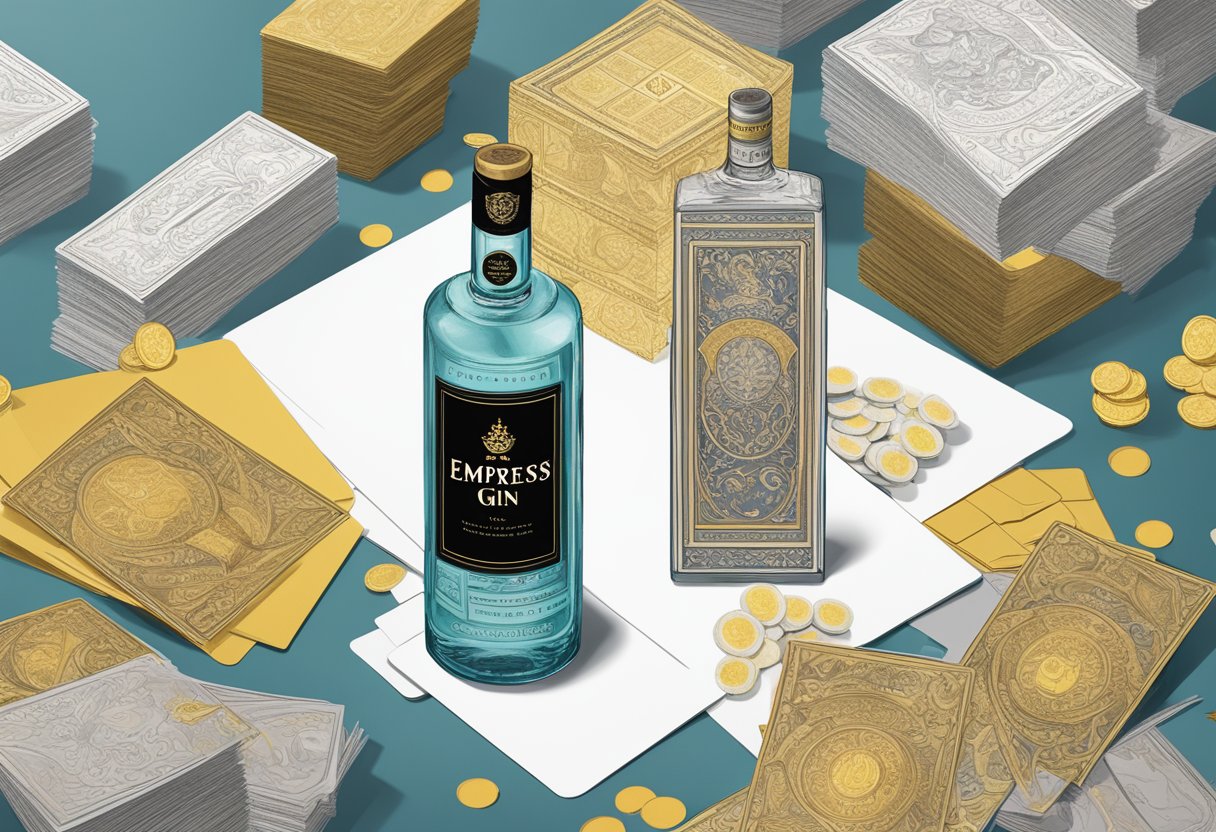
How does Empress Gin achieve its distinctive color?
Empress 1908 Gin, often referred to as Empress 1908, owes its distinctive indigo color to the addition of butterfly pea blossom. This organic component is responsible for both the gin’s vivid shade and its remarkable ability to shift color when combined with specific mixers like citrus or tonic water.
What botanicals are used in the flavor profile of Empress Gin?
Empress 1908 Gin crafts its unique flavor profile using a medley of eight botanicals, each lending a varied array of flavors to the liquor. The blend encompasses classic gin components such as juniper, coriander, and grapefruit peel, complemented by other distinctive botanicals like cinnamon, rose petals, and ginger, as well as the exclusive addition of Fairmont Empress tea, all contributing to the gin’s distinctive flavor profile.
Can you explain the taste difference between Empress Gin and traditional gins?
Empress 1908 Gin, while retaining certain characteristics of conventional gins like the juniper and citrus elements, offers a more contemporary flavor twist. The incorporation of rose petals, tea, and various other botanicals endows the spirit with a uniquely modern palate. Its nuanced floral undertones and a hint of gentle spiciness result in a richer, more intricate taste experience that sets it apart from traditional gins.
What is the most recommended way to serve Empress Gin to enhance its unique characteristics?
The ability of Empress 1908 Gin to change color makes it a perfect option for visually stunning cocktails. They are as appealing to the eye as they are to the palate. To truly savor the gin’s distinctive flavors, experts often suggest enjoying a basic Gin and Tonic. This simple serving method highlights the gin’s singular qualities. Adding a garnish like grapefruit or lemon slice, or a sprig of rosemary, can enhance the gin’s taste even further.
Where is Empress Gin distilled and what is the history of the distillery?
Victoria Distillers, located in Sidney, British Columbia, is the birthplace of Empress 1908 Gin. Established more than ten years ago by a team of skilled artisans devoted to producing high-quality spirits, this distillery formed a partnership with the renowned Fairmont Empress Hotel in Victoria. This collaboration brought together their distillation prowess and the hotel’s signature tea blend, leading to the creation of Empress Gin.
How does the inclusion of Elderflower influence the taste of Empress Gin?
Although elderflower isn’t a listed botanical in Empress 1908 Gin, the subtle floral flavors in the gin can evoke a taste reminiscent of elderflower. This characteristic is likely due to the presence of other floral components such as rose petals, which play a significant role in shaping the gin’s aromatic and complex flavor palette.
Downloads
- Bombay Sapphire: The Artful Blend of Exotic Botanicals
- Crown Royal Salted Caramel
- Belvedere Vodka Price: How Much Does It Cost?
- Glenlivet Founders Reserve: A Classic Whisky with a Modern Twist
- Best Mezcal: An All-Inclusive Guide to Top Selections
- Amazon Bar Stools: Find the Perfect Black Bar Stools with Backs
- Don Julio Tequila Price and Prestige. Sip in Style
- Home Bar Furniture: A Guide for Your Perfect Setup
- Elijah Craig Toasted Barrel: Richness of Fire-Finished Bourbon
- Maker’s Mark Cask Strength: Bold and Intense
- Home Bar Haven: Crafting Unforgettable Gatherings
- The Collins Glass: A Fascinating Journey from A London’s Coffee House to Modern Cocktail Culture
- Buchanan’s Pineapple: A Tropical Twist on Scotch Whisky.
